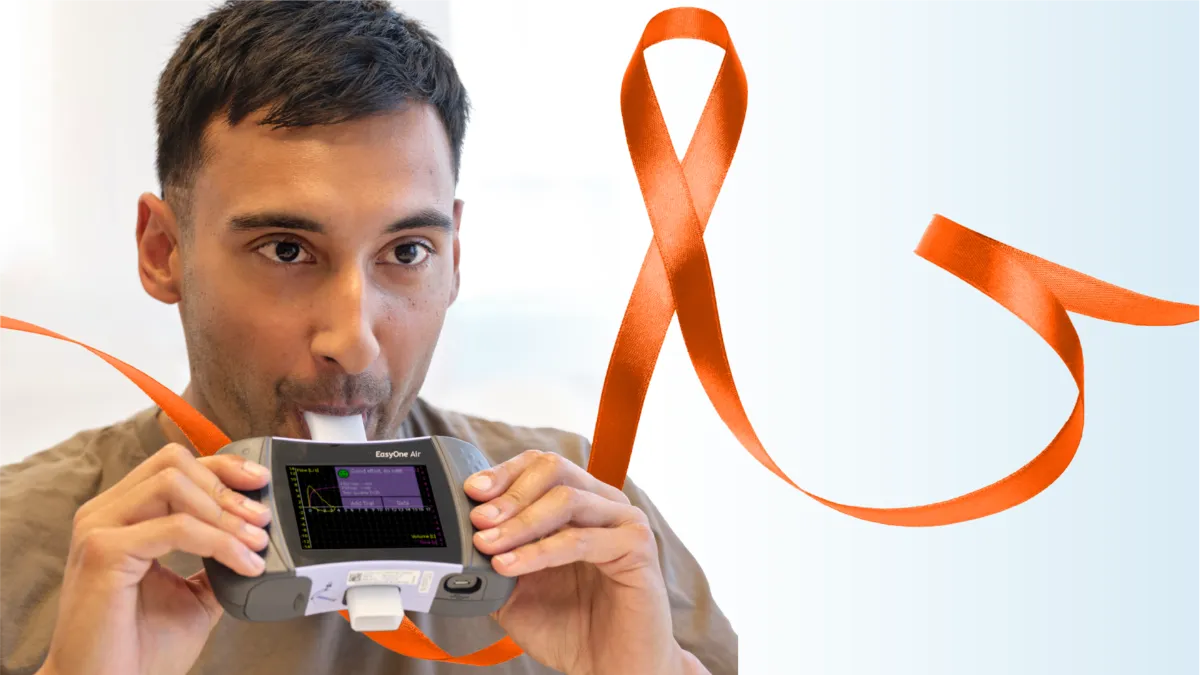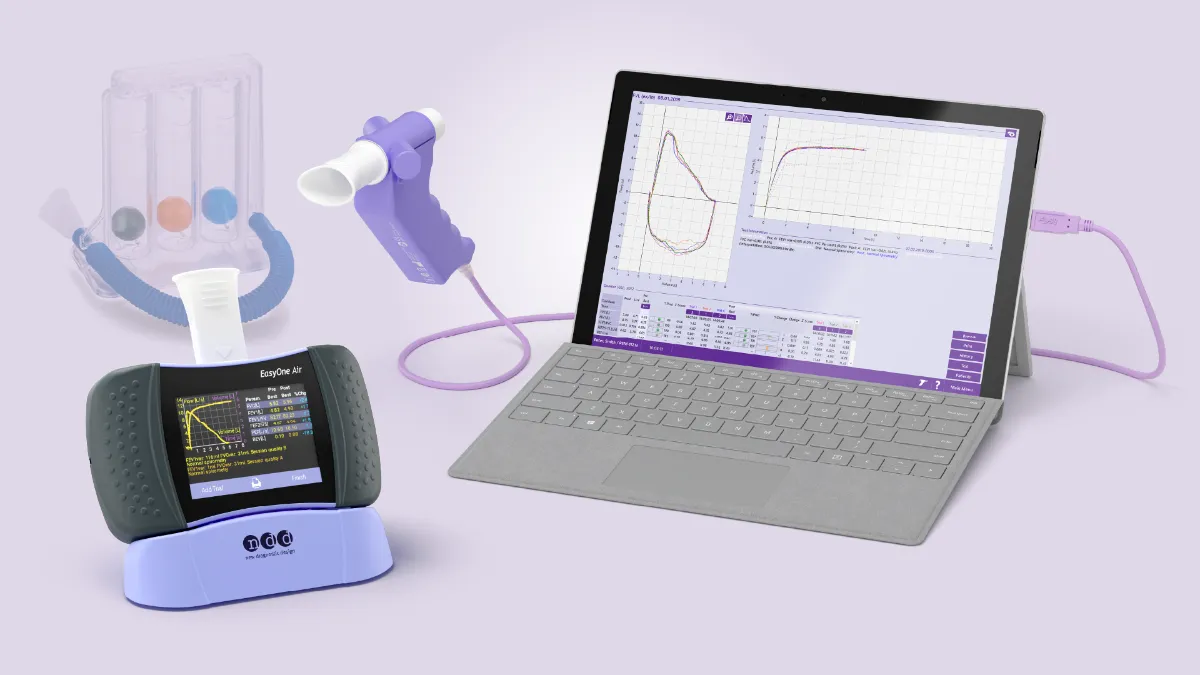Vaping and how it affects lung function

A background on e-cigarettes and vaping #
The United States Patent Office granted the first “non-tobacco smokeless cigarette” patent to Herbert A. Gilbert on August 17, 1965. According to the patent application, smokeless cigarettes could be “safe and harmless” using heated, moist, flavored air instead of burning tobacco. In 2003, a Chinese pharmacist patented the first electronic atomizer cigarette, and by the mid-2000s, e-cigarettes were introduced onto the U.S market.
Today’s electronic cigarettes, or e-cigarettes, have several names, including e-pens, e-pipes, e-hookah, e-cigars, JUULs, vapes, and vape pens, and are collectively known as electronic nicotine delivery systems (ENDS). The lithium-powered devices have cartridges filled with liquid, or ‘vaping juice.’ The liquid is heated and turned into an aerosol vapor for the user to inhale. They do not contain tobacco; however, the liquid typically consists of nicotine, artificial flavorings, and several toxic chemicals.
Despite containing these toxic chemicals, many e-cigarette users consider them a less harmful alternative to conventional cigarette smoking and use them as a tool for smoking cessation.
Vaping and youth #
Widespread advertising through television commercials and social media increased e-cigarette use among adults and teens starting in 2010. In 2013, approximately 13.1 million high school and middle school students were aware of e-cigarettes. In 2019, 25% of US high school seniors were vaping, and in 2022 a CDC study found that 2.55 million high school and middle school students used an e-cigarette at least once in the previous 30 days.
It’s unclear whether adolescents and young adults would have started smoking conventional cigarettes if e-cigarettes weren’t available. Still, there are various reasons why young e-cigarette users find them more appealing than regular cigarettes. In one study, adolescents cited reasons such as curiosity, appealing flavors, use by friends, low cost, and the perception e-cigarettes were healthier than smoking traditional cigarettes.
Since the most common e-cigarette users are young adults, The American Lung Association has repeatedly called upon the Food and Drug Administration (FDA) to increase its oversight of all e-cigarettes and related products to alleviate the growing risk of losing another generation to tobacco-caused diseases.
E-cigarette or vaping product use associated lung injury (EVALI) #
In 2019, the CDC began looking into cases of young patients presenting with a host of respiratory symptoms, including shortness of breath, chest pain, and cough. The one common factor among all the presenting patients was that they had used e-cigarettes or vaping products over the previous three months. Overall, 2807 cases of this idiopathic acute lung injury, predominantly affecting young, healthy adults and adolescents, resulted in 68 deaths, and the condition became known as e-cigarette or vaping-associated lung injury (EVALI).
Along with severe respiratory symptoms, individuals diagnosed with EVALI presented with pulmonary infiltrates on radiographs. They also reported using THC-containing e-cigarettes with vitamin E acetate (VEA) in the liquids. Once these two contributing factors were identified as the primary source of EVALI and a strong public health message was sent out, the surge of EVALI cases began to decline. Investigation and reporting by the CDC ceased in 2020 because of a decline in EVALI patients and the onset of the COVID-19 pandemic. Unfortunately, since VEA was considered to be the most plausible causative agent in EVALI, there continues to be a delay in necessary regulatory assessments of other potential chemicals and toxins responsible for lung injury related to e-cigarettes.
Before the 2019 EVALI outbreak, there were sporadic reports of vaping-related lung injuries. Even though many in the science community abandoned further study of vaping and lung injury after the “close” of the EVALI era, other clinicians, scientists, and public health officials continue to seek answers about the long-term effects and multiple mechanisms of injury vaping presents to the respiratory system.
Vaping aerosols #
The inflammatory effects of vape aerosol causes increased airway resistance, inflammation, and edema with an accumulation of ultrafine particles and heavy metals in the airways. While several of the harmful compounds found in vaping aerosols aren’t present in vaping liquids, the heating conditions on the flavorings seems to generate new compounds in aerosols.
The aerosol compounds also impair pulmonary antibacterial and antiviral defenses, which decrease innate immunity and response to infection, causes oxidative lung stress and induces DNA damage and slows DNA repair.
Unfortunately, the multiple vaping solutions on the market today make it difficult to determine which elements among the different solutions are the most damaging to the lungs.
Future research on vaping and how it affects the lungs #
It can take decades of conventional smoking to develop COPD and most individuals don’t see symptoms appear until their 40s. Long-term effects from vaping are hardly visible yet as it is a fairly new type of smoking.
Therefore additional research is needed to understand the true effect vaping has on respiratory health and lung function. However, there are several hurdles to overcome to identify all the factors that could become damaging to the lungs, including the variations in vaping devices, like the fourth generation vape pens which produce high wattage aerosol that can cause airway injury and hypoxia, not to mention formaldehyde exposure. Also, the vast amount of different vaping liquids and their components produce similar obstacles since some manufacturers claim the flavorants are safe as food additives, yet there is little information about the long-term effect of inhaling these substances into the lungs.
The popularity of vaping continues to grow with innovative vape pen design and attractive nicotine flavors, particularly with the younger generation. Unfortunately, it may take some time to determine the long-term health effects of chronic vaping and its negative impact on the lungs. Until then, healthcare providers can encourage abstention while better public health and policy interventions are established.
Written by

Allison DeMajistre
BSN, RN, CCRN
Allison DeMajistre is a freelance medical writer with a decade of clinical experience as a critical care registered nurse. She writes about cardiology, pulmonology, and several other medical topics. She strives to simplify complex medical information for patients and to write insightful and informative articles for health care professionals.








